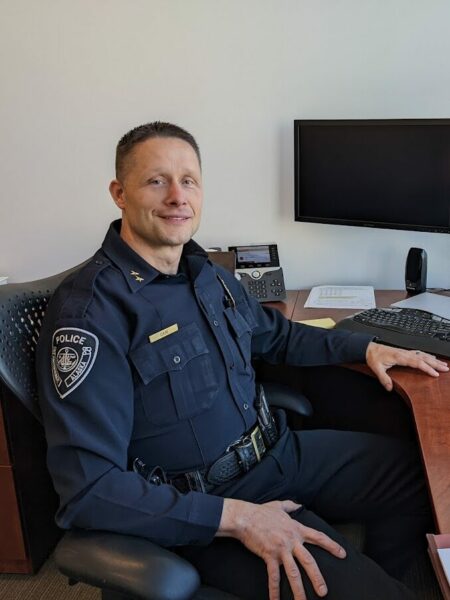Over the summer of 2020, the murder of George Floyd by police officers in Minneapolis set off worldwide protests calling for an end to police violence and racial justice.
In response, many public safety organizations, including the Anchorage Police and Fire Departments, committed to improving diversity in their ranks.
But two years later, data from the Anchorage departments show little change in the share of minority representation among police officers and firefighters.
Police and fire officials point to several reasons why. They say they’re hampered by a tight labor market, limited budgets and recruitment barriers that extend outside of their departments. But critics say police and fire could be doing more, including changing their outreach efforts and setting specific hiring goals with firm deadlines.
“With a goal comes accountability, comes purpose,” said Midtown Assembly member Felix Rivera. “We don’t have that — we just have sort of wishy-washy hopes.”
Anchorage Police Deputy Chief Sean Case said the department is making progress and has more work to do. Assistant Fire Chief Alex Boyd said the same.
“When we’re a group of white males standing up here saying we want to change — really?” he said. “But we do, we really do.”
According to data from the city, the fire department was 87.68% white in April 2022 compared to 87.77% white two years prior. The city as a whole is about 60% white.
At the Anchorage Police Department, the percent of officers who are white has dropped slightly from 78.73% to 77.65%. There were five police officers who identified as Pacific Islanders out of more than 400 officers in the force in 2020. Today, there are four. The number of Black, Alaska Native and Asian officers has also declined in the past two years, though the percentages have stayed about equal.
“There’s more to learn, and we’re gonna get better, but we are proud of where we’re at,” said Case, the deputy chief.
The makeup of public safety organizations is an important issue for public perception and community relations, experts say. It may even help reduce violent interactions with police, as a recent study in Chicago suggests. Achieving a representative police force has been accomplished by some departments around the country, though most still have a disproportionate white representation.
Boyd said the fire department has been hesitant to set specific hiring goals when it wasn’t sure it had the knowledge — or the budgets – to reach its long-term goal of having a representative force. Also, he said, with constant pressure to cut costs, it’s hard to justify spending on recruitment.
“When the discussion becomes a trade-off of we need to close this fire engine, and move those people into a recruiting capacity… Gosh, the community is not very supportive of us closing a fire engine,” he said.
The Assembly recently tried to allocate $50,000 to the Anchorage Police Department to recruit officers reflective of Anchorage’s demographics with a requirement that it report back on its efforts by October. But that money was vetoed by Mayor Dave Bronson, who said it was an inappropriate use of funds from the city’s alcohol tax.
Some community advocates say the issue isn’t money.
“Unless it’s a priority for you, and you’re intentional about seeing these numbers change, it’s going to be business as usual,” said Celeste Hodge Growden, president of the Alaska Black Caucus. “I am disappointed that we are not further along.”
She pointed out that the departments together make up more than 40% of the city’s operating budget. And, she said, she’s been soured about the police’s commitment to diversity after interactions over the past years, including the department declining to sign on to a joint press release denouncing white supremacy following the Jan. 6 attack on the U.S. Capitol building.
Both Case, with the police department, and Boyd, with the fire department, say they are prioritizing diversifying their forces and point to recent changes they’ve made in their hiring and recruiting practices.
The police department has focused on getting rid of barriers that might keep recruits from getting to hiring events, said Case. In some cases, that can even mean giving rides to potential recruits who don’t have access to transportation.
“Instead of just cutting them because they didn’t show up for an interview, maybe they didn’t have adequate transportation,” he said. “It’s that type of thinking that we’ve added.”
Case said the police department is working to transition recruitment material away from images of police cars and SWAT vehicles and instead focus on the department’s community outreach to attract a wider range of applicants.
“We’re making a very focused effort to change that to what we do 90% of the time which is relationship, which is having conversations,” he said.

It also boosted cultural awareness training for incoming and current officers and removed a video from the training curriculum that included a video that a citizens advisory board pointed out included racist depictions of Alaska Natives, Case said.
The fire department has been focusing on broadening its pool of applicants too, according to Boyd. It axed a requirement that applicants have EMT certifications after realizing the vast majority of EMTs are white. It’s retooled many hiring questions, with the help of diversity consultants, to eliminate questions that might not translate to non-white cultures.
Still, Boyd said, the department is running into a catch-22 of recruiting: without a representative force, recruiters are less effective. But to get a more representative force, they need to recruit more people from diverse backgrounds.
“How do we get into a community that we don’t represent well when they may not trust me to show up, and even if they do want me in the room, I’m not a representative of the community,” said Boyd.
On top of all the challenges, there’s the overall tight labor market in the country. Case said despite recruiting its most diverse academy class ever in June 2020, the pool of applicants has shrunk.
“That pool of applicants where people just want to be a cop,” he said, “that well is kind of dry.”
Over the past two years, the number of Anchorage police officers has dropped from 442 to 400, a result of retirements outpacing new hires, said Case.
That’s been a trend around the country, experts say.
“Recruiting officers of any background has been difficult,” said Troy Payne, a professor at the University of Alaska Anchorage Justice Center.
Growden, of the Alaska Black Caucus, said she wants to see more from the police and fire departments when it comes to recruiting.
For example, she said, her group hosts regular Zoom talks on topics important to the Black community and an annual community health fair. She said police and fire haven’t reached out to participate or set up a recruiting table.
“And we’re pretty visible,” she said. “No one has reached out but I am certainly welcoming that opportunity to have them.”
She said she’d like to see police take a more active role at churches and community groups that serve the Black community.
Lucy Hansen, president of the Polynesian Association of Alaska, agreed. She works with the police department doing cultural awareness training where she tells police academy students to not interpret avoiding eye contact as being disrespectful, since it’s a sign of respect in Polynesian culture. She said she’s glad for the opportunity to do the training, but said the police have done little to reach out when applications are open.
“I say, ‘Okay, this is my card, contact me, and let me know if you guys have another opening,’” she said. “I never get that connection until they need me to come do the culture presentation.”
The police department’s efforts at community engagement could also be broader, she said. The city hosts occasional informal community meetings around town called Coffee with a Cop.
“Some cultures — they don’t drink coffee,” said Hansen.
Case and Boyd said they’re continuing to improve, but say there’s more work to do.
“Are we making efforts? Yes,” said Boyd. “Are we making good enough efforts? I would say no. I think we need to be doing a better job.”
[Sign up for Alaska Public Media’s daily newsletter to get our top stories delivered to your inbox.]
Lex Treinen is covering the state Legislature for Alaska Public Media. Reach him at ltreinen@gmail.com.





